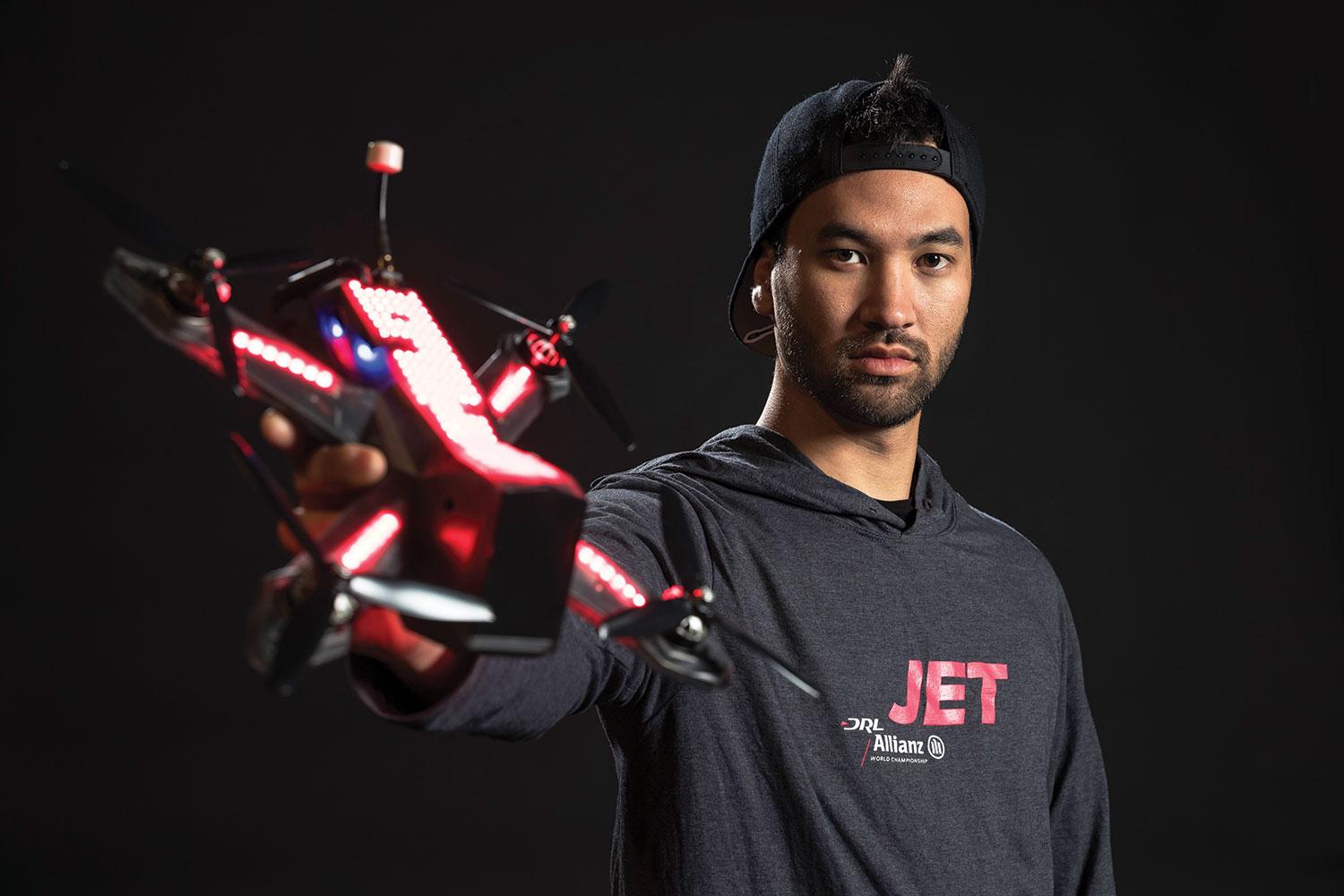
Before they brought him money and a measure of celebrity, drones offered Jordan Temkin (Art’14) a way to stand out.
Eager to distinguish himself from his fellow art students during his senior year at CU, Temkin realized he could use drones to capture footage from unique angles. A skier and photographer from Seattle, he envisioned aerial action shots of his friends on mountain bikes and skis.
All he needed was a drone of his own.
So he built one, using inexpensive parts he bought online and a frame fashioned on his 3D printer.
“It took me about six months before I was actually having fun with it,” said Temkin, 26. “It was more frustrated tinkering up until then.”
After a few troublesome attempts, Temkin successfully flew his drone in September 2014 with a GoPro camera strapped to it. Standing in Boulder’s Chautauqua Park, he pulled on a pair of goggles that live-streamed Flatirons footage as he controlled the drone from the ground.
He felt as if he himself was being transported into the air.
“I absolutely fell in love with that,” he said. “Just the idea of being able to fly.”
The adrenaline rush was the same one he felt while ski racing. And he wanted more of it.
The rewards have been more than he imagined — cash prizes, free trips, a TV show on ESPN and two racing contracts with the Drone Racing League (DRL).

The transition from art student to drone racer was swift.
After graduating in 2014, Temkin worked full time at a Boulder sandwich shop and continued building, flying and racing drones with a few others around Colorado.
Unlike his leisurely flights through Boulder’s canyons and over trees, competitive racing required him to master tricky maneuvers such as careening through hoops and around obstacles at speeds sometimes reaching more than 100 miles per hour. He always wore goggles that allowed him to see only what the drone saw, referred to in the drone world as flying “FPV,” or first-person view. Crashes were — and still are — common.

As drones became more familiar in society at large, so did competitive races. The cash prizes grew. And Temkin often emerged the winner.
He quit his job at the sandwich shop, moved to Fort Collins — which was more drone-friendly than Boulder — and entered races across the U.S., many of which featured up to 150 competitors.
Temkin’s performances caught the attention of the New York-based Drone Racing League, founded in January 2016 by a former Tough Mudder executive.
The league invited Temkin to compete in its inaugural season against 11 other racers in a series of five competitions across the U.S. He readily accepted. The races were filmed in locations as diverse as the Miami Dolphins’ football stadium, the former Bell Labs headquarters in New Jersey and an abandoned Los Angeles mall.
I fell in love with the idea of being able to fly.”
The 10-episode series aired on ESPN in fall 2016. It highlighted competitors’ top-speed thrills as they raced through the dark venues and darted among flashy, neon-lit obstacles. The inevitable crashes were spectacular.
Temkin won the championship, its one-year, $100,000 contract and the title “world’s first professional drone pilot.”
Temkin is the world’s first professional drone pilot.
“Jordan is able to stay in the zone and concentrate when it counts,” said Ryan Gury, DRL’s director of product and technologies. “I remember his first race at Bell Labs. He crashed out of the first few heats and was doing quite poorly. When I approached him to see how he was managing, he smiled and said, ‘All good, man. I just have to win the rest.’ And then he did.”
Boosted by the ESPN broadcast and the fast-growing drone community, Temkin emerged as a leading figure in drone racing.
In DRL’s second season, he again took the championship — filmed in London — and another $100,000, year-long contract. His parents were in attendance. All told, DRL’s first two seasons attracted more than 55 million broadcast views in more than 75 countries, said Gury.
“I can see myself doing this for as long as I can get away with it,” said Temkin, who adopted the pilot name “JET,” his initials.
Temkin occasionally prepares himself for competition by setting up a course filled with hula hoops and soccer goals with the nets cut out. But that’s not his favorite way to practice.
Instead — as he did at the start of it all — he prefers to grab his drone, drive to the mountains, slip on his goggles and fall into the reverie of flight.
“I get to go to the very top of mountains,” he said.
Photos courtesy Drone Racing League





